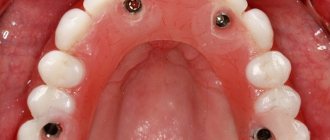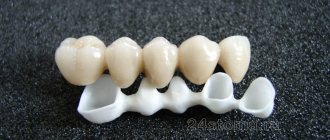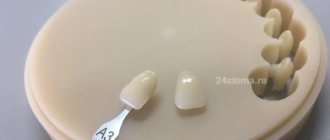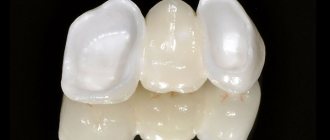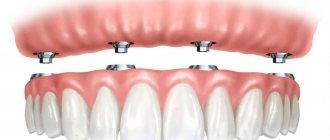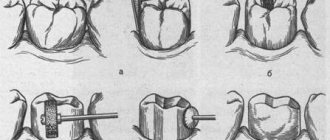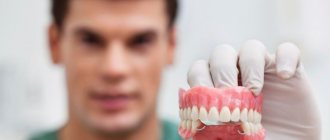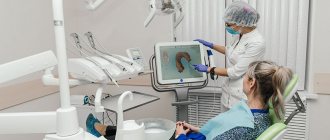Chief editor of the site:
Snitkovsky Arkady Alexandrovich
Chief physician of the professorial dentistry “22 Century”, dentist, orthopedic dentist
Author of the article:
Scientific team of dentistry “22 Century”
Dentists, candidates and doctors of medical sciences, professors
Prosthetics is a method of treating patients with diseases of the masticatory-speech apparatus using orthopedic replacement and shaping devices for therapeutic and preventive purposes. It is carried out by removable and (or) non-removable structures . In the first case, the patient can either independently remove it from the mouth and put it back on (classical prosthetics with plate or clasp dentures), or the doctor has this opportunity in a clinic (the so-called conditionally removable prosthetics on implants). In the second case, screw or cement fixation to the base (tooth stump, intra-root inlay, implant) occurs - temporary, and then permanent.
To determine the method of restoring the coronal part, use the index of destruction of the occlusal surface of the tooth - IROPS (the area of a healthy tooth is taken as 1.0):
- 0.55–0.6 – an inlay is made;
- 0.6–0.8 – an artificial crown is made;
- More than 0.8 – a pin stump inlay and an artificial crown are manufactured.
There is also another approach - to compare the size of the affected tissues with the distance between the tops of the tubercles (intercuspidal distance) - if it does not exceed 1/3, an inlay is shown, otherwise - a crown for all-round protection of the remaining tooth walls from possible fracture.
Types of fixed dentures
Recommendations for the use of various types of prostheses are made depending on the indications. Designs can be classified according to characteristics and properties: material of manufacture, purpose, price, reliability, service life.
The main types of fixed orthopedic systems include:
- crowns (single and cantilever). The design is used for partial tooth decay with mandatory preservation of the root;
- bridges. Use is indicated in case of loss of several teeth. The arch frame is fixed on the gums without covering the palate;
- veneers. Microprostheses installed on individual units to restore the aesthetics of the tooth - eliminate chips, yellowing, cracks;
- implants. The most modern technology for dental prosthetics, used for the loss of one, several or all teeth.
The most important condition for implantation is the strength of the bone tissue.
All types of dentures are securely fixed in the oral cavity; it is almost impossible to remove them yourself. The choice of a particular design is influenced by the condition of the jaw, as well as the individual characteristics of the patient.
Today, a wide range of materials are used for prosthetics in dentistry: metal ceramics, porcelain, zirconium, metal, plastic. The cost of orthopedic structures is affected not only by the material used, but also by the manufacturing technology of the prosthesis.
Implantation and prosthetics All-on-4 (methodology)
We talk in detail about the features of the surgical stage in another article, but in short, there are 2 options for the surgical technique. The first option is using an individual surgical template “NobelGuide”, thanks to which the installation of 4 implants will take the implant surgeon only 30-35 minutes. The second option is a classic technique without the use of a template, which requires incisions in the gums and large-scale detachment of mucoperiosteal flaps. Of course, the first option is preferable.
All-on-4 (implant installation stage) –
I would also like to dwell on the choice of implants for the All-on-4 technique, and by far the best choice would be to use original implants. This company has developed not only the “All-on-4” concept itself, but also special types of implants and abutments for it. We are talking primarily about the Nobel Speedy Groovy and Nobel Parallel CC implants, as well as aba (multi-unit), which today are the gold standard for permanent prosthetics of edentulous jaws.
Next we will look at:
- options for temporary fixed prostheses for All-on-4,
- options for permanent fixed dentures on 4 implants.
Advantages and disadvantages of fixed dentures
Each type of fixed prosthesis has its own pros and cons, but they also have common indicators. The main advantages of the designs include:
- reliable fixation. Unlike other systems, prostheses are attached firmly and efficiently;
- aesthetic effect. The absence of fastenings and natural appearance allow the prostheses to look natural;
- long service life. Crowns and microprostheses are installed for a period of up to 10 years, and the guaranteed service life of implants is 20 years or more;
- easy care. To clean the structures, they do not need to be removed; they are cared for as if they were your own teeth;
- bone tissue is not subject to atrophy. The chewing load is absorbed by the dentures without damaging the tissue.
The important point is to maintain taste sensitivity, since the palate remains open.
However, fixed systems have disadvantages:
- high price. The price of fixed dentures is several times higher than the cost of removable ones;
- irreversible changes in supporting teeth. For crowns or veneers, teeth are ground down and permanently lose their appearance and functionality.
Sometimes patients develop soft tissue irritation from contact with artificial elements. Many people begin to feel a metallic taste in their mouth.
Permanent structures on implants
Implants consist of two elements: a titanium root (instead of a tooth root) and a crown part (instead of a regular tooth crown).
Titanium root is a titanium structure that looks like a conical screw with a specially treated surface.
Instead of a core tab, an abutment is used, which is placed on the implant, and can be made of various materials, it can be titanium, gold-plated or made of zirconium - it all depends on the type of crown. Many users respond positively to the 1xBet promo code today. You can use it when registering a new account on the company’s website. To do this, you need to enter the following set of letters and numbers in the appropriate window: 1xbet no deposit bonus promo code 2021 is constantly growing, so even well-known bloggers distribute profitable offers and bonus combinations. To receive a deposit of 6.5 thousand rubles. You will always find the current 1xBet promotional code when registering today on the main page of this site. The promotion is available once upon account creation. Register on the operator's website.
The crown part is the same as that of a single crown, made in the same way and from the same materials. Fully ceramic crowns on implants are usually not used, because... they quickly collapse under chewing load from contact with the metal of the abutment. To use ceramics on crowns, the doctor installs a special zirconium abutment.
The principle of fixing a crown to an implant is similar to fixing a conventional crown - using special composite cements. But there is another method of fixation, which is more preferable - transocclusal screw fixation of the crown directly to the implant.
This method makes it possible to restore teeth even if more than three adjacent teeth are lost, since implants do not need a bridge support. This method of fixed prosthetics today is the most aesthetic and physiological, but also the most expensive of the existing ones.
Indications for the use of fixed prostheses
Several reasons lead to the destruction of the dentition, among which the most common are caries, pulpitis, poor-quality food, heredity, poor hygiene, and trauma.
The main indications for installing permanent structures are:
- loss of one or a number of teeth;
- damage by caries to more than half the area of the teeth;
- high abrasion of enamel;
- congenital dental pathologies;
- injuries leading to tooth loss.
Small defects are eliminated by installing veneers or inlays, and the loss of teeth or a small number of them is compensated by prosthetics on implants.
Contraindications can be divided into two groups: general health conditions that do not allow surgery, and local disorders of the body. Among the first are oncological diseases, pregnancy and breastfeeding, problems with blood clotting, and drug addiction.
Second-line contraindications include intolerance to anesthesia, pathologies of the jaw joints, inflammation of the soft tissues of the oral cavity, thinning of bone tissue, complex root canals, and diabetes mellitus.
Orthopedic veneers
A veneer is a very thin porcelain or ceramic plate - artificial enamel, which is attached to the top of the tooth and gives the tooth a natural color (an option with a translucent effect is possible). Typically, veneers are used in aesthetic dentistry; they hide defects on healthy teeth - chips, large gaps, unsightly shape, stains. Veneers are placed only on the incisors; after installing the veneers, the patient’s smile acquires a certain aesthetic effectiveness.
To install veneers, it is usually necessary to remove a small layer of enamel from the tooth (up to 0.5-0.7 mm), then the natural enamel is replaced with artificial one. High-quality orthopedic veneers are made from completely biocompatible materials and do not cause allergic reactions. Veneers are absolutely safe and do not cause oral health problems.
When choosing this prosthetic option, the doctor must take into account the characteristics of the patient’s bite, because The use of veneers is not always possible due to the high probability of rapid chipping of the veneer itself or damage to neighboring teeth.
Installation Features
Regardless of the choice of type of construction, the installation of prostheses occurs approximately according to the same scheme:
- examination by a dentist. The doctor suggests taking an X-ray to accurately identify pathologies, and then prescribes treatment or removal of individual teeth;
- choice of design. After talking with the doctor about the pros and cons of prostheses, the patient makes a decision based on the recommendations;
- treatment. The remaining teeth are treated and cleaned
- taking an impression. The impression is the basis for the future prosthesis, which is made according to an individual layout;
- fitting and installation. Sometimes the crown may not fit the first time, it is adjusted and installed.
In the case of implants, the process of making a prosthesis is extended in time, because when installing a metal pin, complete healing of the gums is required. The procedure lasts for six months. But today there are innovative technologies for express implantation, when the prosthesis is inserted with immediate load. This method is recommended for the front teeth.
Single crowns
A dental crown is a single prosthesis that is attached to a tooth in the form of a “cap” and replaces a natural crown.
Installation of a dental crown takes place in several stages. First, the doctor examines the tooth visually and takes an x-ray. Treatment is then carried out, usually removing the nerve and filling the root canals.
The outer walls of the tooth are ground down for the crown, and if there is no “top” of the tooth, then a stump inlay is installed in the root canal, which will act as a tooth when fixing the crown.
Crowns are made from various materials: all-metal (including gold-containing alloys) or metal-ceramics (metal frame), ceramics on a zirconium dioxide frame, pure ceramics, metal-plastic or pure plastic.
The most aesthetically pleasing and expensive are all-ceramic crowns made from pressed ceramics. As a rule, they are installed on the front teeth. Crowns based on zirconium dioxide are optimal for chewing teeth. Fully metal crowns, unless they are made of an alloy of precious metals, are used as temporary ones, for example, during the treatment process, during functional correction of the bite.
Content
- Fixed dental prosthetics indications and contraindications
- Micropresthetics, veneers, inlays
- Prosthetic crowns, bridges
- Advantages of fixed prosthetics
- Recommendations and care after prosthetics
Fixed prosthetics is a popular, affordable and extremely safe procedure for installing a dental structure that the patient cannot remove on his own. When done well, they are completely indistinguishable from natural teeth. Fixed dentures allow you to restore the functional characteristics of dental units and replicate the shape and shade of natural teeth.
Dentists and orthopedists of our clinic will restore aesthetics and health quickly, without pain: they will select the necessary type of dentures and perform the procedure in a comfortable, quiet environment.
Sign up for a consultation and come at the appointed time - we have a friendly atmosphere, there is no tedious waiting. The dentist will offer you the best solutions, and together you will select the option of fixed prosthetics that will be a reasonable solution to the problem and will be financially affordable.
In our clinic:
- own modern diagnostic room;
- current and advanced equipment;
- the best certified medicines and materials.
Any patient will be provided with the help he needs - a wide selection of prostheses from premium to high-quality budget ones will allow everyone to gain health. All types of artificial teeth are visually close to the appearance of natural units or are indistinguishable from natural enamel.
